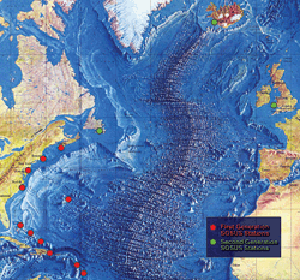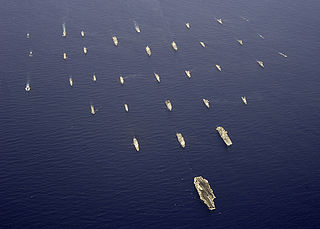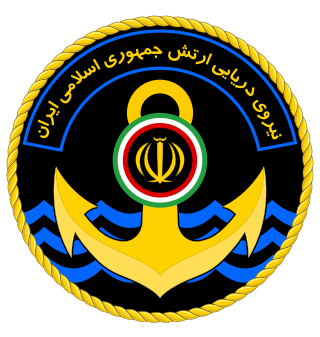Related Research Articles

The Virginia class, also known as the SSN-774 class, is a class of nuclear-powered cruise missile fast-attack submarines, in service in the United States Navy. Designed by General Dynamics Electric Boat (EB) and Huntington Ingalls Industries, the Virginia class is the United States Navy's latest submarine model, which incorporates the latest in stealth, intelligence gathering, and weapons systems technology.

The United States Fleet Forces Command (USFF) is a service component command of the United States Navy that provides naval forces to a wide variety of U.S. forces. The naval resources may be allocated to Combatant Commanders such as United States Northern Command (USNORTHCOM) under the authority of the Secretary of Defense. Originally formed as United States Atlantic Fleet (USLANTFLT) in 1906, it has been an integral part of the defense of the United States of America since the early 20th century. In 2002, the Fleet comprised over 118,000 Navy and Marine Corps personnel serving on 186 ships and in 1,300 aircraft, with an area of responsibility ranging over most of the Atlantic Ocean from the North Pole to the South Pole, the Caribbean Sea, Gulf of Mexico, and the waters of the Pacific Ocean along the coasts of Central and South America.

The Sound Surveillance System (SOSUS) was a submarine detection system based on passive sonar developed by the United States Navy to track Soviet submarines. The system's true nature was classified with the name and acronym SOSUS themselves classified. The unclassified name Project Caesar was used to cover the installation of the system and a cover story developed regarding the shore stations, identified only as a Naval Facility (NAVFAC), being for oceanographic research. In 1985, as the fixed bottom arrays were supplemented by the mobile Surveillance Towed Array Sensor System (SURTASS) and other new systems were coming on line, the name itself changed to Integrated Undersea Surveillance System (IUSS). The commands and personnel were covered by the "oceanographic" term until 1991 when the mission was declassified. As a result, the commands, Oceanographic System Atlantic and Oceanographic System Pacific became Undersea Surveillance Atlantic and Undersea Surveillance Pacific, and personnel were able to wear insignia reflecting the mission.

The littoral combat ship (LCS) is either of two classes of relatively small surface vessels designed for operations near shore by the United States Navy. It was "envisioned to be a networked, agile, stealthy surface combatant capable of defeating anti-access and asymmetric threats in the littorals". Littoral combat ships are comparable to corvettes found in other navies.

Underwater warfare is one of the three operational areas of naval warfare, the others being surface warfare and aerial warfare. It refers to combat conducted underwater such as:

Future planning of the Royal Navy's capabilities is set through periodic Defence Reviews carried out by the British Government. The Royal Navy's role in the 2020s, and beyond, is outlined in the 2021 defence white paper, which was published on 22 March 2021. The white paper is one component of the Integrated Review of Security, Defence, Development and Foreign Policy, titled as Global Britain in a Competitive Age which was published on 16 March 2021.

A deep-submergence vehicle (DSV) is a deep-diving crewed submersible that is self-propelled. Several navies operate vehicles that can be accurately described as DSVs. DSVs are commonly divided into two types: research DSVs, which are used for exploration and surveying, and DSRVs, which are intended to be used for rescuing the crew of a sunken navy submarine, clandestine (espionage) missions, or both. DSRVs are equipped with docking chambers to allow personnel ingress and egress via a manhole.

A blue-water navy is a maritime force capable of operating globally, essentially across the deep waters of open oceans. While definitions of what actually constitutes such a force vary, there is a requirement for the ability to exercise sea control at long range.

The Islamic Republic of Iran Navy, officially abbreviated NEDAJA, is the naval warfare service branch of Iran's regular military, the Islamic Republic of Iran Army (Artesh). It is one of Iran's two maritime military branches, alongside the Navy of the Islamic Revolutionary Guard Corps (IRGC).

A green-water navy is a maritime force that is capable of operating in its nation's littoral zones and has limited competency to operate in the surrounding marginal seas. It is a relatively new term, and has been created to better distinguish, and add nuance, between two long-standing descriptors: blue-water navy and brown-water navy.

The United States Naval Undersea Museum is a naval museum located at Keyport, Washington. It is one of the 10 Navy museums that are operated by the Naval History & Heritage Command. It sits next to a branch of the Naval Undersea Warfare Center.

Ghadir is a class of midget submarines built by Iran specifically for cruising within the shallow waters of the Persian Gulf. The Islamic Republic of Iran Navy is the sole operator of this class, whose all submarines serve in the Southern Fleet. No submarine of this class is active at the Northern Fleet, i.e. the Caspian Sea.

The United States Navy (USN) is the maritime service branch of the United States Armed Forces and one of the eight uniformed services of the United States. It is the largest and most powerful navy in the world, with the estimated tonnage of its active battle fleet alone exceeding the next 13 navies combined, including 11 allies or partner nations of the United States as of 2015. It has the highest combined battle fleet tonnage and the world's largest aircraft carrier fleet, with eleven in service, two new carriers under construction, and five other carriers planned. With 336,978 personnel on active duty and 101,583 in the Ready Reserve, the United States Navy is the third largest of the United States military service branches in terms of personnel. It has 290 deployable combat vessels and more than 2,623 operational aircraft as of June 2019.

The Naval Sea Systems Command (NAVSEA) is the largest of the United States Navy's five "systems commands," or materiel organizations. From a physical perspective, NAVSEA has four shipyards for shipbuilding, conversion, and repair, ten "warfare centers", the NAVSEA headquarters, located at the Washington Navy Yard, in Washington D.C., and other locations in 15 states and 3 overseas continents.
Underwater domain awareness (UDA) is the aspect of maritime domain awareness focused on the underwater sector, including, from a security perspective, sea lines of communication (SLOC), coastal waters and varied maritime assets with reference to hostile intent and the proliferation of submarine and mine capabilities intended to limit access to the seas and littoral waters. The military requirement is not the only motivation for undersea domain awareness. The earth's undersea geophysical activities as they relate to the well-being of humans is also relevant, as monitoring such activities can provide vital clues to minimize the impact of devastating natural disasters.

William Rhode Merz is a retired United States Navy vice admiral who last served as deputy chief of naval operations for operations, plans and strategy from August 6, 2021 to October 7, 2022. He previously served as commander of U. S. Seventh Fleet from 2019 to 2021.

The six Naval Sea Systems Command Program Executive Offices(PEOs) are responsible for the development and acquisition of naval platforms and weapons systems. Their mission is to develop, acquire, field and sustain affordable and integrated state of the art equipment for the Navy and Marine Corps.
The Multi-Role Ocean Surveillance Ship (MROSS) is a type of research and surveillance ship currently in development for the United Kingdom's Royal Fleet Auxiliary. Two ships are currently planned with them both being used by the RFA to research and protect critical undersea national infrastructure, such as undersea cables and gas pipelines, in both British and international waters.
The SSN(X) program, also known as the Next-Generation Attack Submarine program, is a United States Navy program to develop a class of nuclear attack submarines to succeed its Virginia-class and Seawolf-class attack submarines. The SSN(X) program is still in the early stages of development and no official details have been released about its design or capabilities.
References
- ↑ Carr, Christopher; Franco, Jahdiel; Mierzwa, Cheryl; Shattuck, Lewis B.; Suursoo, Melissa. "SEABED WARFARE AND THE XLUUV" (PDF). calhoun.nps.edu. Naval Postgraduate School. Retrieved 4 March 2021.
- ↑ Glenney, Bill. "THE DEEP OCEAN: SEABED WARFARE AND THE DEFENSE OF UNDERSEA INFRASTRUCTURE, PT. 1". cimsec.org. Center for International Maritime Security. Retrieved 4 March 2021.
- ↑ Johnson, Bridget. "Russia's 'Seabed Warfare' Could Hit Vast Networks of Underwater Communications Cables". www.hstoday.us. Homeland Security Today. Retrieved 4 March 2021.
- ↑ Saperstein, Hadrien T. "The Royal Thai Navy's Theoretical Application of the Maritime Hybrid Warfare Concept". centreasia.eu. Centre Asia. Retrieved 4 March 2021.
- ↑ Cregge, Kyle. "FIGHTING FOR THE SEAFLOOR: FROM LAWFARE TO WARFARE". cimsec.org. The Center for International Maritime Security. Retrieved 4 March 2021.
- ↑ Vavasseur, Xavier. "France Unveils New Seabed Warfare Strategy". navalnews.com. Naval News. Retrieved 16 February 2022.
- ↑ Eckstein, Megan. "Navy New Virginia Block VI Virginia Attack Boat Will Inform SSN(X)". news.usni.org. USNI. Retrieved 4 March 2021.
- ↑ Roth, Andrew. "Fire kills 14 sailors on Russian top-secret navy submersible". www.theguardian.com. Retrieved 4 March 2021.
- ↑ MAKICHUK, DAVE. "Silent running: China embraces undersea warfare". asiatimes.com. Asia Times. Retrieved 4 March 2021.